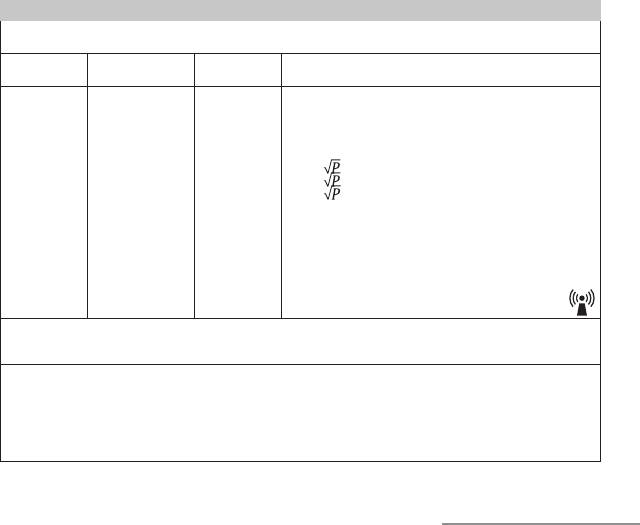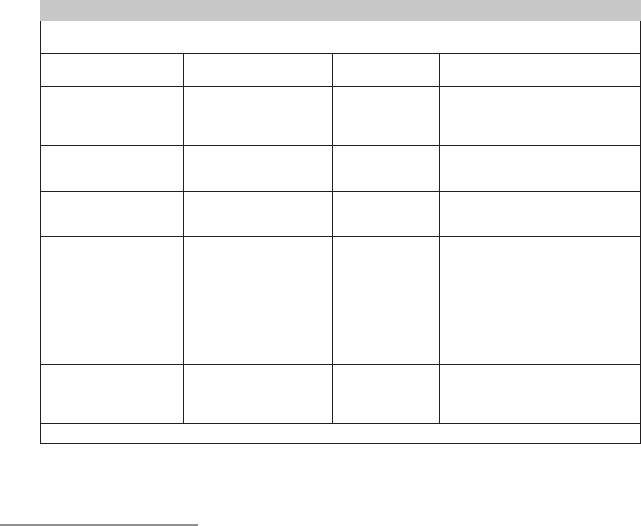Beurer FT 90: Electromagnetic Compatibility Information
Electromagnetic Compatibility Information: Beurer FT 90

Electromagnetic Compatibility Information
Table 1
For all ME EQUIPMENT and ME SYSTEMS
Guidance and manufacturer’s declaration – electromagnetic emissions
The FT 90 is intended for use in the electromagnetic environment specied below.
The customer or the user of the FT 90 should assure that it is used in such an environment.
Emissions test Compliance Electromagnetic environment – guidance
RF emissions CISPR 11 Group 1 The FT 90 uses RF energy only for its internal function.
Therefore, its RF emissions are very low and are not likely to
cause any interference in nearby electronic equipment.
RF emissions CISPR 11 Class B The FT 90 is suitable for use in all establishments, including
domestic establishments and those directly connected to
Harmonic emissions IEC 61000-3-2 Not applicable
the public low-voltage power supply network that supplies
Voltage uctuations/icker emissions
Not applicable
buildings used for domestic purposes.
IEC 61000-3-3
138

Table 2
For all ME EQUIPMENT and ME SYSTEMS
Guidance and manufacturer’s declaration – electromagnetic immunity
The FT 90 is intended for use in the electromagnetic environment specied below.
The customer or the user of the FT 90 should assure that it is used in such an environment.
Immunity test IEC 60601 test
Compliance
Electromagnetic environment – guidance
level
level
Portable and mobile RF communications equipment should
be used no closer to any part of the FT 90, including cables,
than the recommended separation distance calculated from
the equation applicable to the frequency of the transmitter.
Recommended separation distance
Conducted RF
3 Vrms
Not applicable
IEC 61000-4-6
150 kHz to 80 MHz
d = 1.2
d = 1.2 80 MHz to 800 MHz
d = 2.3
800 MHz to 2.5 GHz
where P is the maximum output power rating of the transmit-
ter in watts (W) according to the transmitter manufacturer and
Radiated RF
3 V/m
d is the recommended separation distance in meters (m).
3 V/m
IEC 61000-4-3
80 MHz to 2.5 GHz
Field strengths from xed RF transmitters, as determined by
an electromagnetic site survey, a should be less than the
compliance level in each frequency range b.
Interference may occur in the vicinity of equipment
marked with the following symbol:
NOTE 1 At 80 MHz and 800 MHz, the higher frequency range applies.
NOTE 2 These guidelines may not apply in all situations.
Electromagnetic propagation is aected by absorption and reection from structures, objects and people.
a. Field strengths from xed transmitters, such as base stations for radio (cellular/cordless) telephones and land
mobile radios, amateur radio, AM and FM radio broadcast and TV broadcast cannot be predicted theoretically with
accuracy. To assess the electromagnetic environment due to xed RF transmitters, an electromagnetic site survey
should be considered. If the measured eld strength in the location in which the FT 90 is used exceeds the appli-
cable RF compliance level above, the FT 90 should be observed to verify normal operation. If abnormal perfor-
mance is observed, additional measures may be necessary, such as reorienting or relocating the FT 90.
b. Over the frequency range 150 kHz to 80 MHz, eld strengths should be less than 3 V/m.
139

Table 3
For ME EQUIPMENT and ME SYSTEMS that are not LIFE-SUPPORTING
Guidance and manufacturer’s declaration – electromagnetic immunity
The FT 90 is intended for use in the electromagnetic environment specied below.
The customer or the user of the FT 90 should assure that it is used in such an environment.
Immunity test IEC 60601 test level Compliance level Electromagnetic environment –
guidance
Electrostatic discharge
6 kV contact
6 kV contact
Floors should be wood, concrete or
(ESD)
8 kV air
8 kV air
ceramic tile. If oors are covered with
IEC 61000-4-2
synthetic material, the relative humi-
dity should be at least 30 %.
Electrical fast transient/
2 kV for power supply lines
Not applicable Mains power quality should be that
burst
1 kV for input/output lines
of a typical commercial or hospital
IEC 61000-4-4
environment.
Surge
1 kV line(s) to line(s)
Not applicable Mains power quality should be that
IEC 61000-4-5
2 kV line(s) to earth
of a typical commercial or hospital
environment.
interruptions and voltage
< 5 % UT (> 95 % dip in UT)
Not applicable Mains power quality should be that
variations on power sup-
for 0.5 cycle
of a typical commercial or hospi-
ply input lines
tal environment. If the user of the
40 % UT (60 % dip in UT)
IEC 61000-4-11
FT 90 requires continued operation
for 5 cycles
during power mains interruptions, it is
70 % UT (30 % dip in UT)
recommended that the FT 90 be pow-
for 25 cycles
ered from an uninterruptible power
supply or a battery.
< 5 % UT (> 95 % dip in UT)
for 5 sec
3 A/m 3 A/m Power frequency magnetic elds
Power frequency
should be at levels characteristic of a
(50/60 Hz) magnetic eld
typical location in a typical commer-
IEC 61000-4-8
cial or hospital environment.
NOTE UT is the a.c. mains voltage prior to application of the test level.
140

Table 4
For ME EQUIPMENT and ME SYSTEMS that are not LIFE-SUPPORTING
Recommended separation distances between portable and mobile RF communications equipment and the FT90
The FT 90 is intended for use in an electromagnetic environment in which radiated RF disturbances
are controlled. The customer or the user of the FT 90 can help prevent electromagnetic interference by
maintaining a minimum distance between portable and mobile RF communications equipment (trans-
mitters) and the FT 90 as recommended below, according to the maximum output power of the commu-
nications equipment.
Separation distance according to frequency of transmitter
m
Rated maximum output
power of transmitter
150 kHz to 80 MHz
80 MHz to 800 MHz
800 MHz to 2.5 GHz
W
d = 1.2
d = 1.2
d = 2.3
0.01 0.12 0.12 0.23
0.1 0.38 0.38 0.73
1 1.2 1.2 2.3
10 3.8 3.8 7.3
100 12 12 23
For transmitters rated at a maximum output power not listed above, the recommended separation
distance d in meters (m) can be estimated using the equation applicable to the frequency of the trans-
mitter, where P is the maximum output power rating of the transmitter in watts (W) according to the
transmitter manufacturer.
NOTE 1 At 80 MHz and 800 MHz, the separation distance for the higher frequency range applies.
NOTE 2 These guidelines may not apply in all situations. Electromagnetic propagation is aected by
absorption and reection from structures, objects and people.
141

D
Kontaktloses Fieberthermometer FT 90
142

143

752.877 – 0314 Irrtum und Änderungen vorbehalten
144
Оглавление
- Sehr geehrte Kundin, sehr geehrter Kunde,
- Einflüsse auf die Körpertemperatur
- Dear customer,
- Influences on body temperature
- Chère cliente, cher client,
- Éléments influant la température corporelle
- Estimada clienta, estimado cliente:
- Factores que influyen en la temperatura corporal
- Gentile cliente,
- Fattori che influenzano la temperatura corporea
- Sayın müşterimiz,
- Vücut sıcaklığını etkileyen faktörler
- Уважаемый покупатель,
- Факторы влияния на температуру тела
- Szanowna Klientko, szanowny Kliencie!
- Czynniki wpływające na temperaturę ciała
- Electromagnetic Compatibility Information




